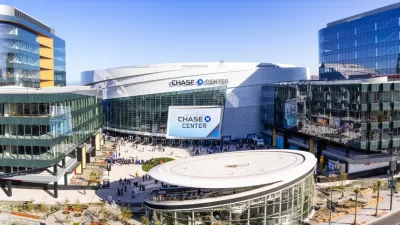Architects in Baltimore are arguing that the city should build its new arena near its other sports facilities, freeing up the old location for redevelopment that can help revitalize its downtown.
"Did Baltimore make a mistake by opening what is now called the 1st Mariner Arena on a prime downtown parcel 46 years ago?
That's the conclusion of a group of local architects who recommend Baltimore find another site for the new arena city officials want to build, rather than construct it on the same spot as the current one at 201 W. Baltimore St.
The architects say the present arena, originally known as the Baltimore Civic Center, is a "dead zone" for much of the day and fails to add much vitality to the central business district. They say a better location for a new arena would be south of Oriole Park at Camden Yards and M&T Bank Stadium, where it could be part of a larger sports and entertainment district.
The architects also say that moving the arena would free up the present site for new development that could support the city's revitalization efforts on the west side of downtown, including housing, stores and offices. A more "finely grained" and "multi-tiered" mixture of uses, they contend, would do more to rejuvenate the surrounding area than an arena because it would add people and activity to the area around the clock.
"If Baltimore is to build a new arena, it shouldn't be on the current site," said Klaus Philipsen, one of the architects making recommendations about a future arena."
FULL STORY: Architects argue for a different site for a new arena

Maui's Vacation Rental Debate Turns Ugly
Verbal attacks, misinformation campaigns and fistfights plague a high-stakes debate to convert thousands of vacation rentals into long-term housing.

Planetizen Federal Action Tracker
A weekly monitor of how Trump’s orders and actions are impacting planners and planning in America.

Chicago’s Ghost Rails
Just beneath the surface of the modern city lie the remnants of its expansive early 20th-century streetcar system.

Bend, Oregon Zoning Reforms Prioritize Small-Scale Housing
The city altered its zoning code to allow multi-family housing and eliminated parking mandates citywide.

Amtrak Cutting Jobs, Funding to High-Speed Rail
The agency plans to cut 10 percent of its workforce and has confirmed it will not fund new high-speed rail projects.

LA Denies Basic Services to Unhoused Residents
The city has repeatedly failed to respond to requests for trash pickup at encampment sites, and eliminated a program that provided mobile showers and toilets.
Urban Design for Planners 1: Software Tools
This six-course series explores essential urban design concepts using open source software and equips planners with the tools they need to participate fully in the urban design process.
Planning for Universal Design
Learn the tools for implementing Universal Design in planning regulations.
planning NEXT
Appalachian Highlands Housing Partners
Mpact (founded as Rail~Volution)
City of Camden Redevelopment Agency
City of Astoria
City of Portland
City of Laramie




























